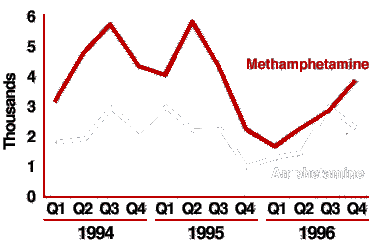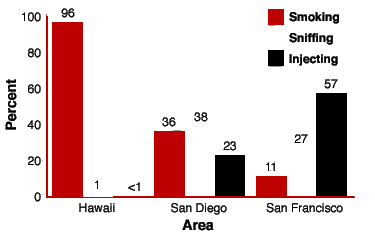|
National Institute on Drug Abuse
Research Report Series
Methamphetamine: Abuse and Addiction
What is methamphetamine?
Methamphetamine is a powerfully
addictive stimulant that dramatically affects the central nervous system.
The drug is made easily in clandestine laboratories with relatively
inexpensive over-the-counter ingredients. These factors combine to make
methamphetamine a drug with high potential for widespread abuse.
Methamphetamine is commonly known as "speed," "meth," and "chalk."
In its smoked form it is often referred to as "ice," "crystal," "crank,"
and "glass." It is a white, odorless, bitter-tasting crystalline powder
that easily dissolves in water or alcohol. The drug was developed early
in this century from its parent drug, amphetamine, and was used originally
in nasal decongestants and bronchial inhalers. Methamphetamine's chemical
structure is similar to that of amphetamine, but it has more pronounced
effects on the central nervous system. Like amphetamine, it causes increased
activity, decreased appetite, and a general sense of well-being. The
effects of methamphetamine can last 6 to 8 hours. After the initial
"rush," there is typically a state of high agitation that in some individuals
can lead to violent behavior.
Methamphetamine is a Schedule II stimulant, which means it has a high
potential for abuse and is available only through a prescription that
cannot be refilled. There are a few accepted medical reasons for its
use, such as the treatment of narcolepsy, attention deficit disorder,
and -- for short-term use -- obesity; but these medical uses are limited.
What is the scope of methamphetamine
use in the United States?
Methamphetamine abuse, long reported
as the dominant drug problem in the San Diego, CA, area, has become
a substantial drug problem in other sections of the West and Southwest,
as well. There are indications that it is spreading to other areas of
the country, including both rural and urban sections of the South and
Midwest. Methamphetamine, traditionally associated with white, male,
blue-collar workers, is being used by more diverse population groups
that change over time and differ by geographic area.
According to the 1996 National Household Survey on Drug Abuse, an estimated
4.9 million people (2.3 percent of the population) have tried methamphetamine
at some time in their lives. In 1994, the estimate was 3.8 million (1.8
percent), and in 1995 it was 4.7 million (2.2 percent).
Data from the 1996 Drug Abuse Warning Network (DAWN), which collects
information on drug-related episodes from hospital emergency departments
in 21 metropolitan areas, reported that methamphetamine-related episodes
decreased by 39 percent between 1994 and 1996, after a 237 percent increase
between 1990 and 1994. There was a statistically significant decrease
in methamphetamine-related episodes between 1995 (16,200) and 1996 (10,800).
However, there was a significant increase of 71 percent between the
first half of 1996 and the second half of 1996 (from 4,000 to 6,800).
NIDA's Community
Epidemiology Work Group (CEWG), an early warning network of researchers
that provides information about the nature and patterns of drug use
in major cities, reported in its June 1997 publication that methamphetamine
continues to be a problem in Hawaii and in major Western cities, such
as San Francisco, Denver, and Los Angeles. Increased methamphetamine
availability and production are being reported in diverse areas of the
country, particularly rural areas, prompting concern about more widespread
use.
| Methamphetamine and amphetamine use is on the rise |
|
 |
|
Source: Drug Abuse Warning Network, SAMHSA, 1997
Quarterly emergency room episodes due to
stimulant use were tracked from 1994 to 1996. A shortage of
methamphetamine was reported by epidemiologists during the last
half of 1995 accounting for the significant decrease in ER episodes.
|
Drug abuse treatment admissions reported by the CEWG in December 1996
showed that methamphetamine remained the leading drug of abuse among
treatment clients in the San Diego area and was second only to marijuana
in Hawaii. Stimulants, including methamphetamine, accounted for smaller
percentages of treatment admissions in other states and metropolitan
areas of the West (e.g., 5 percent in Los Angeles and Seattle and 4
percent in Texas and San Francisco). By comparison, stimulants were
the primary drugs of abuse in less than 1 percent of treatment admissions
in most Eastern and Midwestern metropolitan areas, except in Minneapolis-St.
Paul and St. Louis, where they accounted for approximately 2 percent
of total admissions.
| The
preferred method of taking methamphetamine varies among geographical
regions |
 |
Note: Calendar year in Hawaii and San
Diego; State fiscal year in San Francisco.
Source: Community Epidemiology Work Group, NIDA 1997 |
|














